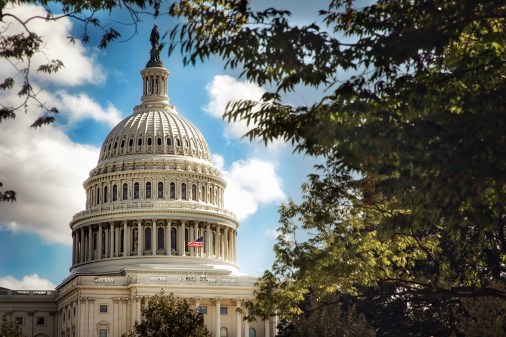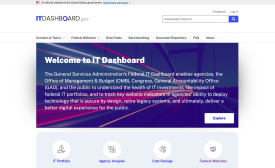As part of the Administration’s Campaign to Cut Waste initiative, federal government technology leaders held a live chat yesterday to discuss streamlining and improving the federal executive branch .gov domain ecosystem. The discussion was led by White House Director of Digital Strategy Macon Phillips, U.S. Chief Information Officer Vivek Kundra and Director of the General Services Administration’s Center for Excellence in Digital Government Sheila Campbell, who fielded citizen questions from Facebook and Twitter.
A .gov Task Force (full list below) selected by Kundra and comprised of federal employees across all levels of government is leading the effort with support from the Office of Management and Budget, General Services Administration, Office of Science and Technology Policy, Chief Information Officers Council and Federal Web Managers Council.
According to data provided by Data.gov, the federal government manages 1,759 second-level .gov domains, 354 of which are simple redirects.
Kundra:
“If you look at a lot of these Websites, I’ve got to tell you, it’s disappointing when you look at them and you realize that they been designed with folks that were thinking about information architecture from the 1980s and 1990s. Part of what we’re going to be doing is making sure that we’re looking at game-changing technologies to be able to serve up content, and those game-changing technologies, part of we want to do is make sure they’re used to simplify access.”
Campbell:
“A big part of this effort … is that agencies are going to be asked to complete a comprehensive inventory of all their .gov domains, and that’s going to happen in the next couple of weeks. Agencies will be required to answer important questions about every single domain they own. Questions like ‘who owns the Website?, ‘when was it last updated?,’ ‘what’s the purpose of the site?,’ ‘who’s the audience?,’ ‘what are the top tasks?,’ so it’s really going to be a very comprehensive review so that agencies can look at this data and make sound business decisions as to what the next step is with that Website. They’re going to be looking at not just individual Websites, but also Websites across their organization for identifying opportunities for reducing duplication. Agencies will be looking at the content … infrastructure … all the different services that go into maintaining that Website and look for opportunities for more cost-efficient ways to manage that Website … As part of their customer service plans, they’re going to be required to publicly explain what they’re planning to do with each of these Websites.”
Phillips:
“Solving the problem of making government information services more available online isn’t just about better Websites. It’s about understanding how these people are getting this information. One of the really exciting projects that GSA is working on is ‘Search USA,’ and I think that’s a really good example of approaching this problem not just from a narrow standpoint of building better Websites, but thinking more holistically about the citizens’ experience in terms of getting federal information.”
Kundra, Campbell and Phillips also addressed a number of usability and technology issues, including leveraging search to enhance user experience, archiving federal records and the rise and role of mobile devices in meeting citizen needs:
“More and more users are leveraging mobile devices to access their government … and part of what this task force is also going to be doing is looking at how do we make sure that we’re prepared to serve the American people in the context that they want to deal with their government rather than us pushing Websites,” said Kundra.
As part of the process, the Administration put a 90-day freeze on creation of new .gov domains, and a full list of current federal executive branch domains was made public on Data.gov. A .gov Task Force was created to give recommendations for updating policy and best practices. There will also be a review of federal websites “to eliminate those that are duplicative and outdated and identify opportunities to strengthen and coordinate content across agencies.”
Learn more about the .gov reform effort on USA.gov.
Video of Live Chat
.gov Task Force Members
- Frank Baitman, Chief Information Officer, Social Security Administration
- Les Benito, Director, Public Web at Defense Media Activity
- Sheila Campbell, Director, Center for Excellence in Digital Government, Office of Citizen Services, General Services Administration
- Sarah Crane, Director USA.gov, Office of Citizen Services, General Services Administration
- Cammie Croft, Senior Advisor, Director of New Media and Citizen Engagement, Department of Energy
- Lee Ellis, Program Manager, .gov Domain, Office of Governmentwide Policy, General Services Administration
- Nick Fraser, Office of Information and Regulatory Affairs, Office of Management and Budget, Executive Office of the President
- Mike Liddell, New Media Manager, Department of Treasury
- Dan Munz, IT Specialist, Consumer Financial Protection Bureau
- Janice Nall, Office of E-Gov and Information Technology, Office of Management and Budget, Executive Office of the President
- Adam Neufeld, Office of Management and Budget, Executive Office of the President
- Todd Park, Chief Technology Officer, Health and Human Services
- Macon Phillips, Director of Digital Strategy, The White House
- Rand Ruggieri, EGov Program Manager, Department of Commerce
- Janet Stevens, Chief Information Officer, Food Safety and Inspection Service, Department of Agriculture
- Kodiak Starr, Creative Director of New Media, Executive Office of the President
- Chris Vein, Deputy U.S. Chief Technology Officer for Government Innovation, Office of Science and Technology Policy, Executive Office of the President






